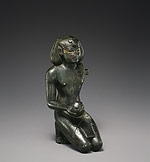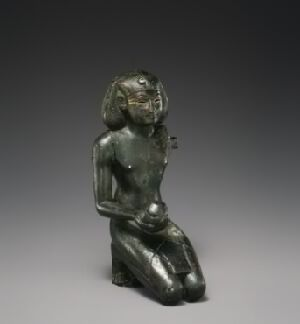Kneeling Statue of Tuthmosis III
 Kneeling Statue of Tuthmosis
III, 1479–25 B.C.; Dynasty 18, reign of Tuthmosis III; New
Kingdom
Kneeling Statue of Tuthmosis
III, 1479–25 B.C.; Dynasty 18, reign of Tuthmosis III; New
Kingdom
Egyptian
Black bronze, gold; H. 5 3/8 in. (13.6 cm)
Purchase, Edith Perry Chapman Fund and Malcolm Hewitt Wiener
Foundation Inc. Gift, 1995 (1995.21)
Description
"Beautifully poised, this small bronze king offers wine or milk to a god. The fluid, athletic modeling of his body and details of his costume indicate a date in mid–Dynasty 18. In fact, the statuette represents the great king Tuthmosis III, as is revealed by traces of his prenomen, Menkheperre, on the belt buckle.
This figure is the earliest known New Kingdom royal bronze statuette and, with a few Late Middle Kingdom copper and copper-alloy precursors, it initiates the tradition of bronze statuary in Egypt. It is a "black" bronze, darkened to heighten the luster of its precious metal inlays. The left eye rim and the nipples retain their original gold inlay. The body of the statuette was solid cast, with separately cast arms (one is missing) fitted onto dowels.
Kneeling bronze kings are found irregularly among the New Kingdom excavations and then in greater numbers in those of the Third Intermediate and Late periods. Their appearance is almost certainly associated with the growing emphasis on the public aspects of Egyptian religion. Such figurines are frequently represented on the great processional barks of the gods, expressing the respectful yet dignified role of the king—himself a god—in ensuring the continuing worship of the gods." - MET

Copyright © 2001 The Metropolitan Museum of Art - MET